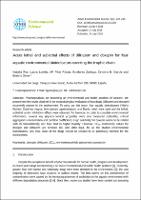Por favor, use este identificador para citar o enlazar este ítem:
https://repositorio.usj.es/handle/123456789/287
Registro completo de metadatos
| Campo DC | Valor | Lengua/Idioma |
|---|---|---|
| dc.contributor.author | Ros, Natalia | - |
| dc.contributor.author | Lomba Eraso, Laura | - |
| dc.contributor.author | Ribate, Mª Pilar | - |
| dc.contributor.author | Zuriaga Marco, Estefanía | - |
| dc.contributor.author | García García, Cristina Belén | - |
| dc.contributor.author | Giner Parache, Beatriz | - |
| dc.date.accessioned | 2020-01-14T10:51:59Z | - |
| dc.date.available | 2020-01-14T10:51:59Z | - |
| dc.date.issued | 2018-07-24 | - |
| dc.identifier.citation | Laura Lomba, M. Pilar Ribate, Estefanía Zuriaga, Cristina B. García, Beatriz Giner, Acute and subacute effects of drugs in embryos of Danio rerio. QSAR grouping and modelling, Ecotoxicology and Environmental Safety, 2019, 172, 232, 10.1016/j.ecoenv.2019.01.081 | es_ES |
| dc.identifier.issn | 2372-0352 | es_ES |
| dc.identifier.uri | https://repositorio.usj.es/handle/123456789/287 | - |
| dc.description.abstract | Pharmaceuticals are becoming an environmental and health problem of concern. We present here the results obtained in the ecotoxicological evaluation of two drugs (diltiazem and doxepin) recurrently present in the environment. To carry out this study, four aquatic bioindicators (Vibrio fischeri, Daphnia magna, Selenastrum capricornutum, and Danio rerio) were used and the lethal, sublethal and/or inhibition effects were obtained. Furthermore, in order to complete environmental information, several key physicochemical properties were also measured (solubility, critical aggregation concentration and partition coefficient). High solubility for doxepin seems to be related with its bioavailability and thus, lead to higher toxicity. However, EC50 ecotoxocity values for doxepin and diltiazem are between 100 and 1000 mg/L for all the studied environmental bioindicators, and thus, none of the drugs should be considered as potentially harmful for the environment. | es_ES |
| dc.format.extent | 15 p. | es_ES |
| dc.format.mimetype | application/pdf | es_ES |
| dc.language.iso | eng | es_ES |
| dc.publisher | AMER INST MATHEMATICAL SCIENCES-AIMS, PO BOX 2604, SPRINGFIELD, MO 65801-2604 USA | es_ES |
| dc.relation | GREENLIFE (E105) acknowledges financial support from Gobierno de Aragon and Fondo Social Europeo "Construyendo Europa desde Aragon". Furthermore, GREENLIFE acknowledges financial support from Ministerio de Economia y Competitividad (CTQ2013-44867-P) and FEDER. Finally, GREENLIFE thanks EEE53 SL. Business groups: Pinares de Venecia Division Energetica and Brial (ENATICA) for support. Both business groups are committed to sustainable developments through environmental respect. | es_ES |
| dc.relation.requires | Adobe PDF | es_ES |
| dc.rights | Attribution-NonCommercial-NoDerivatives 4.0 Internacional | * |
| dc.rights.uri | http://creativecommons.org/licenses/by-nc-nd/4.0/ | * |
| dc.subject | Doxepin | es_ES |
| dc.subject | Diltiazem | es_ES |
| dc.subject | EC50 | es_ES |
| dc.subject | Environmental risk assessment | es_ES |
| dc.subject | Ecotoxicity | es_ES |
| dc.title | Acute lethal and sublethal effects of diltiazem and doxepin for four aquatic environmental bioindicators covering the trophic chain | es_ES |
| dc.type | info:eu-repo/semantics/article | es_ES |
| dc.subject.unesco | Medio ambiente | es_ES |
| dc.subject.unesco | Evaluación del impacto ambiental | es_ES |
| dc.relation.publisherversion | https://www.aimspress.com/article/10.3934/environsci.2018.4.229 | es_ES |
| dc.identifier.doi | 10.3934/environsci.2018.4.229. | es_ES |
| dc.rights.accessrights | info:eu-repo/semantics/openAccess | es_ES |
| Aparece en las colecciones: | Artículos de revistas | |
Ficheros en este ítem:
| Fichero | Descripción | Tamaño | Formato | |
|---|---|---|---|---|
| s12889-018-6070-9.pdf | 826,2 kB | Adobe PDF |  Visualizar/Abrir |
Este ítem está sujeto a una licencia Creative Commons Licencia Creative Commons

